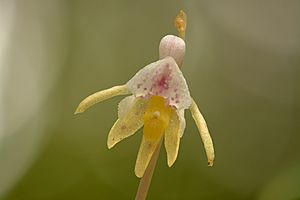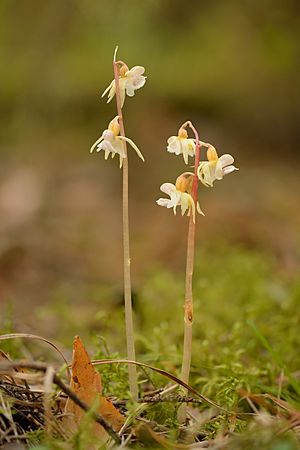Ghost orchid facts for kids
Quick facts for kids Ghost orchid |
|
|---|---|
 |
|
| Habit | |
 |
|
| Ghost orchid flower | |
| Conservation status | |
| Scientific classification | |
| Genus: |
Epipogium
|
| Species: |
aphyllum
|
| Synonyms | |
|
Satyrium epipogium L. |
|
The ghost orchid (Epipogium aphyllum) is a very special and rare plant. It's not like most plants because it doesn't have any chlorophyll. This means it can't make its own food using sunlight, like green plants do. Instead, it gets its food from tiny fungi in the soil. This way of living is called myco-heterotrophy.
This orchid is famous for being hard to find. It pops up very rarely, and sometimes it's only seen once in a certain place. You can find it in forests with trees like beech, oak, pine, and spruce, especially where the soil has lots of minerals.
The ghost orchid is very rare and is in danger of disappearing in many places. People thought it had vanished from the United Kingdom, but it was seen there again in 2009! Because it's so rare, this plant is protected in many areas. It's very important not to pick these plants or disturb them, even for science.
In 1926, a Welsh plant expert named Eleanor Vachell was asked by the British Museum to look into a report of the ghost orchid in England. For many years, the Welsh National Herbarium had only a small piece of the plant that Vachell had collected.
How the Ghost Orchid Lives
Scientists first thought these plants were saprophytic. This means they were believed to get food from dead or decaying matter. But now we know they are actually mycoheterotrophs. This is a fancy way of saying they get their food from fungi.
These fungi live in the soil and are connected to the roots of conifer trees, like pines and spruces. The orchid basically "borrows" nutrients from these fungi. It grows from an underground stem that doesn't have chlorophyll. The plant only comes above ground to flower, especially during very wet summers.
The ghost orchid can be found in many parts of the world. Its range stretches across much of Europe and northern Asia, from Spain all the way to the Kamchatka Peninsula. You can also find it south in the Himalayas. However, even though it's spread out, it's still incredibly rare in each place. These plants always grow in areas that have cold winters.
The underground stems of the orchid are full of special fungi. These fungi are usually the kind that form mushrooms and live in a helpful partnership with the roots of conifer trees.
The ghost orchid partners with many different types of fungi. Studies have shown that a fungus called Inocybe is often found with 75% of these orchids. Other fungi like Hebeloma, Xerocomus, Lactarius, and Thelephora can also be involved. Some other tiny fungi also seem to help the orchid get nutrients from its main fungal partners.
It's almost impossible to grow these plants outside of a lab. This is because they need very specific fungi to survive. They also need those fungi to be connected to specific host trees. When a large ghost orchid plant does flower, it can be an amazing sight. It might have up to a dozen flower stalks, each with 3 or 4 flowers, growing right out of the pine needles on the forest floor.
See also
 In Spanish: Epipogium aphyllum para niños
In Spanish: Epipogium aphyllum para niños



